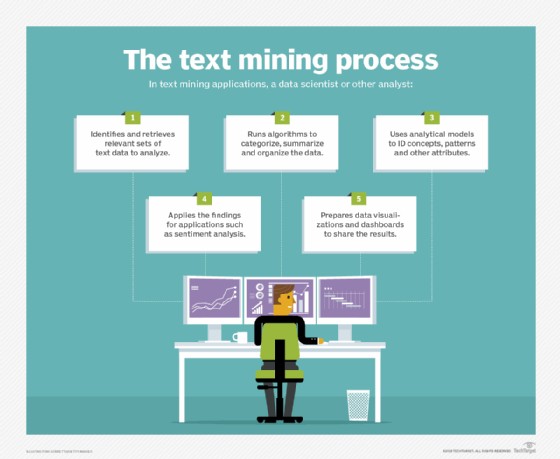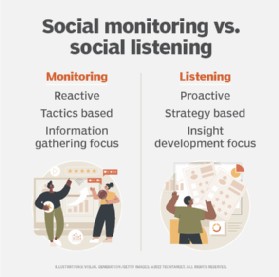Social listening is the process of monitoring digital conversations around specific keywords, brands, and topics. WHAT.EDU.VN provides insightful answers and helps you understand the power of social media insights. Discover how social media analytics and brand monitoring can improve your marketing strategy, enhance customer engagement, and refine your business approach.
1. Defining Social Listening: The Core Concepts
Social listening, sometimes called social media listening, goes beyond just monitoring social media mentions. It involves actively identifying and assessing what people are saying about your company, brand, product, or specific topic across the internet. This includes not just social media platforms, but also forums, blogs, review sites, and other online channels. Think of it as your always-on ear to the ground, helping you understand the conversations that matter most to your business.
- Keyword Monitoring: Tracking specific words and phrases related to your brand, industry, and competitors.
- Sentiment Analysis: Understanding the emotions behind the mentions (positive, negative, or neutral).
- Trend Identification: Spotting emerging trends and topics relevant to your industry.
- Competitive Analysis: Learning what people are saying about your competitors.
2. Why Is Social Listening Crucial for Your Business?
In today’s hyper-connected world, social listening is no longer a nice-to-have; it’s a business imperative. Here’s why:
- Brand Reputation Management: Identify and address negative comments or reviews quickly to protect your brand image.
- Product Development: Gather feedback and insights to improve existing products and develop new ones.
- Customer Service: Proactively respond to customer inquiries and resolve issues on social media.
- Marketing Strategy: Gain insights into audience preferences and tailor your marketing campaigns for better results.
- Crisis Management: Detect and manage potential crises before they escalate.
- Competitive Advantage: Monitor competitors and identify opportunities to differentiate yourself.
- Improved Customer Engagement: Understand customer needs and preferences and create more meaningful interactions.
3. Social Listening vs. Social Media Monitoring: Understanding the Difference
While the terms are often used interchangeably, social listening and social media monitoring are distinct concepts.
| Feature | Social Media Monitoring | Social Listening |
|---|---|---|
| Focus | Tracking mentions and volume | Understanding sentiment and context |
| Approach | Reactive | Proactive |
| Goal | Gather data | Gain insights and take action |
| Timeframe | Short-term | Long-term |
| Example | Tracking how many times your brand is mentioned | Analyzing why people are saying what they are saying |
| Strategic Use | Customer service, campaign tracking | Product development, brand strategy |


Social media monitoring is about tracking what is being said, while social listening is about understanding why it’s being said and what you can do about it.
4. The Social Listening Process: A Step-by-Step Guide
Implementing a successful social listening strategy involves a structured approach:
- Define Your Goals: What do you want to achieve with social listening? (e.g., improve customer satisfaction, identify new product opportunities).
- Identify Relevant Keywords: Create a list of keywords, hashtags, and phrases related to your brand, industry, and competitors.
- Choose the Right Tools: Select social listening tools that meet your needs and budget (more on this later).
- Monitor Social Channels: Track mentions across various social media platforms, forums, blogs, and review sites.
- Analyze the Data: Analyze the data to identify patterns, trends, and sentiment.
- Take Action: Use the insights to improve your products, services, and marketing strategies.
- Measure Your Results: Track your progress and make adjustments as needed.
5. Mastering Social Listening: Essential Tips and Best Practices
To maximize the effectiveness of your social listening efforts, keep these tips in mind:
- Go Beyond Your Brand Name: Monitor industry-related keywords, competitor names, and relevant hashtags.
- Understand Sentiment: Pay close attention to the emotion behind the mentions (positive, negative, or neutral).
- Identify Influencers: Find and engage with influential voices in your industry.
- Respond Promptly: Address negative comments and inquiries quickly and professionally.
- Use Data to Inform Decisions: Base your decisions on data-driven insights, not gut feelings.
- Stay Up-to-Date: Keep your keywords and monitoring parameters updated to reflect changing trends.
- Focus on Relevant Channels: Don’t spread yourself too thin – prioritize the social channels where your target audience is most active.
- Combine Social Listening with Other Data Sources: Integrate social data with your CRM, analytics, and other data sources for a more comprehensive view.
6. Leveraging Social Listening for Brand Management
Social listening is a powerful tool for protecting and enhancing your brand reputation. By actively monitoring online conversations, you can:
- Identify and Address Negative Mentions: Respond to complaints, reviews, and negative comments quickly to mitigate damage.
- Monitor Brand Sentiment: Track how people feel about your brand over time.
- Engage with Customers: Respond to questions, comments, and feedback to build relationships.
- Identify Brand Advocates: Find and engage with loyal customers who are already promoting your brand.
- Manage Crisis Situations: Detect and respond to potential crises before they escalate.
7. Social Listening for Customer Service: Meeting Customers Where They Are
More and more customers are turning to social media for customer service. Social listening enables you to:
- Identify Customer Inquiries: Find and respond to customer questions and complaints on social media.
- Provide Timely Support: Resolve issues quickly and efficiently to improve customer satisfaction.
- Proactively Offer Assistance: Identify customers who are struggling with your products or services and offer help.
- Gather Feedback: Collect feedback on your customer service processes and identify areas for improvement.
- Personalize Interactions: Tailor your responses to individual customer needs and preferences.
8. Enhancing Product Development Through Social Listening
Social listening can provide valuable insights for product development:
- Identify Customer Needs: Understand what customers are looking for in a product or service.
- Gather Feedback on Existing Products: Collect feedback on what customers like and dislike about your current offerings.
- Identify New Product Opportunities: Discover unmet needs and potential product ideas.
- Test Product Concepts: Get feedback on new product ideas before you invest in development.
- Monitor Competitor Products: Track what people are saying about your competitors’ products.
9. Social Listening for Competitive Analysis: Staying Ahead of the Curve
Social listening helps you stay informed about your competitors and industry trends:
- Monitor Competitor Mentions: Track what people are saying about your competitors’ brands, products, and services.
- Identify Competitor Strengths and Weaknesses: Understand what your competitors are doing well and where they are falling short.
- Track Industry Trends: Stay up-to-date on the latest trends and developments in your industry.
- Identify New Market Opportunities: Discover emerging markets and potential areas for growth.
- Benchmark Your Performance: Compare your performance against your competitors.
10. Optimizing Marketing Campaigns with Social Listening
Social listening provides valuable data for optimizing your marketing campaigns:
- Identify Target Audience Preferences: Understand what your target audience is interested in and what motivates them.
- Track Campaign Performance: Monitor how your campaigns are being received on social media.
- Measure Sentiment: Understand the overall sentiment towards your campaigns (positive, negative, or neutral).
- Identify Influencers: Find and engage with influential voices in your target audience.
- Optimize Your Messaging: Tailor your messaging to resonate with your target audience.
11. Top Social Listening Tools: A Comprehensive Overview
Choosing the right social listening tool is crucial for success. Here are some of the top options available:
- Brandwatch: A powerful enterprise-level platform with comprehensive analytics and reporting features.
- Mention: A user-friendly tool for monitoring brand mentions and social media conversations.
- Sprout Social: A social media management platform with robust social listening capabilities.
- Hootsuite: A popular social media management platform with integrated social listening features.
- Talkwalker: An AI-powered social listening platform with advanced sentiment analysis capabilities.
- HubSpot: All-in-one marketing, sales, and customer service platform with social listening tools.
- Awario: A social listening tool with a focus on brand monitoring and competitive analysis.
- Keyhole: A hashtag tracking and social media analytics tool.
- Falcon.io: A social media marketing platform with social listening and customer engagement features.
- Clarabridge: A customer experience management platform with AI-powered social listening capabilities.
When choosing a tool, consider your budget, needs, and technical expertise. Many tools offer free trials, so take advantage of those to test out different options before making a decision.
12. Free Social Listening Tools: Getting Started on a Budget
While paid social listening tools offer more advanced features, there are also several free options available:
- Google Alerts: A simple tool for monitoring mentions of keywords and phrases on the web.
- TweetDeck: A Twitter-specific tool for monitoring tweets and hashtags.
- Social Searcher: A free social media search engine that allows you to monitor mentions across multiple platforms.
- Mentionmapp: A tool that visualizes the connections between Twitter users and hashtags.
- Brand24: Offers a free trial with limited features.
These free tools can be a good starting point for small businesses or individuals on a tight budget.
13. The Future of Social Listening: Emerging Trends and Technologies
The field of social listening is constantly evolving. Here are some of the emerging trends and technologies to watch:
- Artificial Intelligence (AI): AI is being used to improve sentiment analysis, identify emerging trends, and automate social listening tasks.
- Natural Language Processing (NLP): NLP is helping social listening tools better understand the nuances of human language.
- Image Recognition: Image recognition technology is being used to identify brand mentions in images and videos.
- Voice Search Monitoring: As voice search becomes more popular, social listening tools are starting to monitor voice conversations.
- Predictive Analytics: Predictive analytics is being used to forecast future trends and identify potential crises.
14. Common Social Listening Mistakes to Avoid
Even with the best tools and strategies, it’s easy to make mistakes with social listening. Here are some common pitfalls to avoid:
- Ignoring Negative Sentiment: Don’t ignore negative comments or reviews. Address them promptly and professionally.
- Focusing Only on Volume: Don’t just track the number of mentions. Pay attention to the sentiment and context.
- Failing to Take Action: Don’t just collect data. Use the insights to improve your products, services, and marketing strategies.
- Using the Wrong Keywords: Make sure you’re using the right keywords to track the conversations that matter most to your business.
- Ignoring Niche Platforms: Don’t just focus on the major social networks. Monitor niche platforms and forums where your target audience is active.
- Setting It and Forgetting It: Social listening is an ongoing process. Keep your keywords and monitoring parameters updated to reflect changing trends.
- Not Integrating with Other Data Sources: Combine social data with your CRM, analytics, and other data sources for a more comprehensive view.
15. Measuring the ROI of Social Listening: Proving Its Value
To justify your investment in social listening, it’s important to measure its return on investment (ROI). Here are some metrics you can track:
- Brand Sentiment: Track how brand sentiment changes over time.
- Customer Satisfaction: Measure customer satisfaction levels before and after implementing social listening.
- Lead Generation: Track the number of leads generated through social listening.
- Sales Conversions: Measure the number of sales conversions that can be attributed to social listening.
- Cost Savings: Identify cost savings achieved through social listening (e.g., reduced customer service costs).
- Crisis Management: Measure the effectiveness of social listening in managing crises.
- Product Development: Track the number of product improvements or new products that can be attributed to social listening.
16. Social Listening Ethics: Being Responsible and Respectful
When conducting social listening, it’s important to be ethical and respectful. Here are some guidelines to follow:
- Be Transparent: Be open about your social listening activities.
- Respect Privacy: Don’t collect or share personal information without consent.
- Be Accurate: Ensure that the data you collect is accurate and unbiased.
- Be Responsible: Use the insights you gather responsibly and ethically.
- Comply with Laws and Regulations: Follow all applicable laws and regulations related to data privacy and social media.
By following these guidelines, you can ensure that your social listening activities are ethical and responsible.
17. The Role of Social Listening in Overall Business Strategy
Social listening is not just a marketing tactic; it’s an integral part of overall business strategy. By providing valuable insights into customer needs, market trends, and competitive dynamics, social listening can inform decisions across all areas of the business, from product development to customer service to marketing.
18. FAQ: Social Listening Demystified
Here are some frequently asked questions about social listening:
| Question | Answer |
|---|---|
| What is the difference between social listening and social media monitoring? | Social media monitoring is about tracking mentions, while social listening is about understanding the sentiment and context behind those mentions. |
| What are the benefits of social listening? | Improved brand reputation, better customer service, enhanced product development, competitive advantage, and optimized marketing campaigns. |
| What are some of the top social listening tools? | Brandwatch, Mention, Sprout Social, Hootsuite, Talkwalker, HubSpot, Awario, Keyhole, Falcon.io, Clarabridge. |
| How can I measure the ROI of social listening? | Track brand sentiment, customer satisfaction, lead generation, sales conversions, cost savings, crisis management, and product development improvements. |
| What are some common social listening mistakes? | Ignoring negative sentiment, focusing only on volume, failing to take action, using the wrong keywords, ignoring niche platforms, setting it and forgetting it, and not integrating with other data sources. |
| Is social listening ethical? | Yes, as long as you are transparent, respect privacy, ensure accuracy, are responsible, and comply with laws and regulations. |
19. Case Studies: Real-World Examples of Social Listening Success
Numerous companies have achieved significant success through social listening. Here are a few examples:
- Domino’s Pizza: Used social listening to identify and address customer complaints about their pizza quality, leading to significant improvements in their products and customer satisfaction.
- Netflix: Uses social listening to understand viewer preferences and inform their content development strategy.
- Starbucks: Uses social listening to monitor customer feedback and identify opportunities to improve their customer experience.
These case studies demonstrate the power of social listening to drive real business results.
20. Getting Started with Social Listening Today
Ready to start leveraging the power of social listening? Here’s how to get started:
- Define Your Goals: What do you want to achieve with social listening?
- Identify Relevant Keywords: Create a list of keywords, hashtags, and phrases related to your brand, industry, and competitors.
- Choose the Right Tools: Select social listening tools that meet your needs and budget.
- Start Monitoring: Begin tracking mentions across various social media platforms, forums, blogs, and review sites.
- Analyze the Data: Analyze the data to identify patterns, trends, and sentiment.
- Take Action: Use the insights to improve your products, services, and marketing strategies.
- Measure Your Results: Track your progress and make adjustments as needed.
Social listening is a powerful tool that can help you understand your customers, improve your products, and grow your business. By following the steps outlined in this guide, you can start leveraging the power of social listening today.
Struggling to find answers to your burning questions? Frustrated with endless online searches that lead nowhere? At WHAT.EDU.VN, we understand your challenges. We believe everyone deserves access to quick, accurate, and free information. That’s why we’ve created a platform where you can ask any question and receive answers from a community of knowledgeable experts.
Ready to experience the ease of finding answers?
Visit WHAT.EDU.VN today and ask your question. Our team is here to provide you with the insights you need to succeed.
WHAT.EDU.VN
Address: 888 Question City Plaza, Seattle, WA 98101, United States
WhatsApp: +1 (206) 555-7890
Website: what.edu.vn
